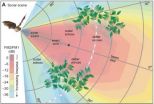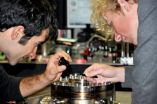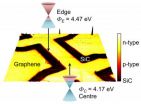(Press-News.org) Over the past decades, the economic sciences have seen fundamental breakthroughs in our understanding of human responses to incentives in the face of uncertainty and strategic interactions. But what is the scope and what are the limits for applying these models in the design of better institutions and better policies? And to what extent can they teach us what is needed to encourage the innovation that drives economic growth and social wellbeing? These are among the questions to be debated among 17 Nobel Laureates in Economic Sciences and approximately 450 aspiring young economists from more than 80 countries in Lindau, Germany, next week. The 5th Lindau Meeting on Economic Sciences will bring them together for a unique dialogue across generations, cultures and scientific backgrounds. The meeting will open on 20 August with a keynote address by the German Chancellor Angela Merkel, and will also feature "a panoramic view on the situation and prospects in Latin America" by Mario Vargas Llosa, the 2010 Nobel Laureate in Literature.
From 20 to 23 August, the participating laureates and the young economists will have plenty of opportunity for an intensive exchange of ideas. The numerous lectures, discussions, master classes and panel discussions of the programme will address central fields of the discipline, ranging from econometrics, game theory, and neo-classical growth theory to mechanism design and systemic risk measurement. The overarching question "How useful is economics – how is economics useful?" will also be subject of the meeting's closing panel debate on Mainau Island on Saturday, 23 August. As a special guest of honour, Queen Silvia of Sweden will attend the concluding events that day.
Economics has always been concerned with incentives. But for a long time, most formal analyses of incentive issues were limited to the behaviour of people or corporations in markets where the institutional environment was given. Since the 1960s, our understanding of incentives and incentive problems has been revolutionised by contributions that identified asymmetric information and strategic interdependence as root causes of incentive problems and provided fundamental insights about the scope for dealing with these problems by institutional design.
Panel Discussion: "Strategic Behaviour, Incentives and Mechanism Design"
The importance of this research was recognised by the award of the Nobel Prize in 1996 to Sir James Mirrlees and William Vickrey for their 'fundamental contributions to the economic theory of incentives under asymmetric information' and in 2007 to Leonid Hurwicz, Eric Maskin and Roger Myerson 'for having laid the foundations of mechanism design theory'. At the Lindau Meeting, a panel discussion entitled "Strategic behaviour, incentives and mechanism design" and featuring the three Nobel laureates Eric Maskin, Sir James Mirrlees and Roger Myerson will discuss the underlying ideas and their development.
Edmund Phelps: "Bringing Dynamism, Home-grown Innovation and Human Flourishing into Economics"
The 2006 Nobel Laureate in Economic Sciences, Edmund Phelps, worries that there has been a loss of dynamism in the western world, which is stalling innovation, reducing productivity growth and threatening our future prosperity. His lecture at the Lindau Meeting, entitled "Bringing dynamism, home-grown innovation and human flourishing into economics" will explore what is needed to restore the grassroots dynamism that can drive transformational innovation for better lives – or what he calls 'mass flourishing'. His view is that most innovation is not driven by a few isolated visionaries, but rather by dynamism on a mass scale: millions of people empowered to dream up, develop and market new products and processes.
Edward Prescott: "Innovation in Neoclassical Growth Theory"
In his lecture "Innovation in neoclassical growth theory", the 2004 Nobel Laureate in Economic Sciences, Edward Prescott, will describe research showing that the predicted GDP gains from openness to direct foreign investment are three times bigger than standard trade models predictions, but still only a third of what the empirics indicate. He will argue that other factors are important, with the leading candidates being lowering the incentives to set barriers to more efficient production and increasing the rate at which knowledge useful in production diffuses.
INFORMATION:
The Lindau Meetings
From their beginning in 1951 as a European initiative of post-war reconciliation, the Lindau Nobel Laureate Meetings have evolved into a unique forum for unconstrained scientific exchange among physiologists, physicists, and chemists. The Lindau Meetings are designed to educate, inspire, and connect. Every year esteemed Nobel laureates and aspiring young scientists from all over the world come together at Lindau to engage in an open dialogue across generations and cultures. Regular meetings on economic sciences were enacted in 2004. Here some of the world's most dedicated young economists have the opportunity to pose the questions and discuss the issues they are most concerned about or interested in.
Incentives, innovation and growth
Core ideas in economic research to be debated by Nobel laureates and aspiring young economists from all over the world in Lindau next week
2014-08-15
ELSE PRESS RELEASES FROM THIS DATE:
New ways to treat solid tumors
2014-08-15
An international team of scientists has shown that an antibody against the protein EphA3, found in the micro-environment of solid cancers, has anti-tumour effects.
As EphA3 is present in normal organs only during embryonic development but is expressed in blood cancers and in solid tumours, this antibody-based approach may be a suitable candidate treatment for solid tumours.
The researchers from Monash University and Ludwig Cancer Research, in Australia, and KaloBios Pharmaceuticals, in the US, have had their findings published in the journal Cancer Research.
The ...
Guidelines can predict early menopause in child cancer survivors
2014-08-15
Girls with cancer who are most likely to become infertile after treatment can be identified using guidelines developed almost 20 years ago, new research shows.
The criteria – developed in Edinburgh – will help to select which girls should be offered the opportunity to freeze some tissue from their ovaries for use in the future.
Doctors are optimistic that the frozen tissue could one day help young cancer survivors to have children of their own.
Some cancer treatments can affect female fertility by bringing on early menopause. Freezing samples of ovary tissue before ...
Bats bolster brain hypothesis, maybe technology, too
2014-08-15
PROVIDENCE, R.I. [Brown University] — Amid a neuroscience debate about how people and animals focus on distinct objects within cluttered scenes, some of the newest and best evidence comes from the way bats "see" with their ears, according to a new paper in the Journal of Experimental Biology. In fact, the perception process in question could improve sonar and radar technology.
Bats demonstrate remarkable skill in tracking targets such as bugs through the trees in the dark of night. Brown University neuroscience Professor James Simmons, the review paper's author, has long ...
A study of possible extended symmetries of field theoretic systems
2014-08-15
There has been much recent interest, especially among cosmologists, in theories known as galileons. Galileons are an interesting and novel, though still hypothetical, class of effective scalar fields which are extremely universal and have attracted much recent attention. They arise generically in describing the short distance behavior of the new degrees of freedom introduced during the process of modifying gravity, and in describing the dynamics of extra dimensional brane worlds. Modified gravity and brane worlds are just some of the ideas that have been studied as possible ...
Low vitamin D levels linked to increased risks after noncardiac surgery
2014-08-15
August 15, 2014 – Patients with low blood levels of vitamin D are at increased risk of death and serious complications after noncardiac surgery, suggests a study in Anesthesia & Analgesia.
"Vitamin D concentrations were associated with a composite of in-hospital death, serious infections, and serious cardiovascular events," according to the new research by Dr Alparslan Turan and colleagues of the Cleveland Clinic. They believe their results warrant further study to see if giving vitamin D supplementation before surgery can reduce the risk of these adverse outcomes.
Lower ...
Study: Brain imaging shows brain differences in risk-taking teens
2014-08-15
According to the CDC, unintentional injuries are the leading cause of death for adolescents. Compared to the two leading causes of death for all Americans, heart disease and cancer, a pattern of questionable decision-making in dire situations comes to light in teen mortality. New research from the Center for BrainHealth at The University of Texas at Dallas investigating brain differences associated with risk-taking teens found that connections between certain brain regions are amplified in teens more prone to risk.
"Our brains have an emotional-regulation network that ...
Laser makes microscopes way cooler
2014-08-15
Laser physicists have found a way to make atomic-force microscope probes 20 times more sensitive and capable of detecting forces as small as the weight of an individual virus.
The technique, developed by researchers at The Australian National University (ANU), hinges on using laser beams to cool a nanowire probe to minus 265 degrees Celsius.
"The level of sensitivity achieved after cooling is accurate enough for us to sense the weight of a large virus that is 100 billion times lighter than a mosquito," said Dr Ben Buchler from the ANU Research School of Physics and Engineering.
The ...
Adipose-derived stem cells and nerve regeneration
2014-08-15
Stem cell researchers at the Blond McIndoe Laboratory, University of Manchester, UK, led by Dr Adam Reid, present a review of the current literature on the suitability of adipose-derived stem cells in peripheral nerve repair.
Injuries to peripheral nerves are common and cause life-changing problems for patients alongside high social and health care costs for society. Current clinical treatment relies on sacrificing a nerve from elsewhere in the body to provide a nerve graft at the injury site, but much work has been done to develop a bioengineered nerve graft that would ...
Politicians need to address transport taboos, not just new technology, to meet carbon targets
2014-08-15
Transport accounts for 30% of CO2 emissions in the EU, with emissions rising 36% between 1990 and 2007. The research, carried out by Lund University and the University of Surrey a found a need to dissect the widely-held view that new technologies, such as biofuel and improved aircraft design, will result in carbon reduction targets being met.
In the paper, researchers highlight the fact that policy makers are turning to the perceived benefits of such technologies to drive decarbonisation policy, despite contrary evidence. They argue that in order to cut damaging carbon ...
On the edge of graphene
2014-08-15
Researchers at the National Physical Laboratory (NPL) have discovered that the conductivity at the edges of graphene devices is different to that of the central material.
Local scanning electrical techniques were used to examine the local nanoscale electronic properties of epitaxial graphene, in particular the differences between the edges and central parts of graphene Hall bar devices. The research was published in Scientific Reports, an open access publication from Nature Publishing Group.
The researchers found that the central part of the graphene channel demonstrated ...
LAST 30 PRESS RELEASES:
Numbers in our sights affect how we perceive space
SIMJ announces global collaborative book project in commemoration of its 75th anniversary
Air pollution exposure and birth weight
Obstructive sleep apnea risk and mental health conditions among older adults
How talking slows eye movements behind the wheel
The Ceramic Society of Japan’s Oxoate Ceramics Research Association launches new international book project
Heart-brain connection: international study reveals the role of the vagus nerve in keeping the heart young
Researchers identify Rb1 as a predictive biomarker for a new therapeutic strategy in some breast cancers
Survey reveals ethical gaps slowing AI adoption in pediatric surgery
Stimulant ADHD medications work differently than thought
AI overestimates how smart people are, according to HSE economists
HSE researchers create genome-wide map of quadruplexes
Scientists boost cell "powerhouses" to burn more calories
Automatic label checking: The missing step in making reliable medical AI
Low daily alcohol intake linked to 50% heightened mouth cancer risk in India
American Meteorological Society announces Rick Spinrad as 2026 President-Elect
Biomass-based carbon capture spotlighted in newly released global climate webinar recording
Illuminating invisible nano pollutants: advanced bioimaging tracks the full journey of emerging nanoscale contaminants in living systems
How does age affect recovery from spinal cord injury?
Novel AI tool offers prognosis for patients with head and neck cancer
Fathers’ microplastic exposure tied to their children’s metabolic problems
Research validates laboratory model for studying high-grade serous ovarian cancer
SIR 2026 delivers transformative breakthroughs in minimally invasive medicine to improve patient care
Stem Cell Reports most downloaded papers of 2025 highlight the breadth and impact of stem cell research
Oxford-led study estimates NHS spends around 3% of its primary and secondary care budget on the health impacts of heat and cold in England
A researcher’s long quest leads to a smart composite breakthrough
Urban wild bees act as “microbial sensors” of city health.
New study finds where you live affects recovery after a hip fracture
Forecasting the impact of fully automated vehicle adoption on US road traffic injuries
Alcohol-related hospitalizations from 2016 to 2022
[Press-News.org] Incentives, innovation and growthCore ideas in economic research to be debated by Nobel laureates and aspiring young economists from all over the world in Lindau next week


